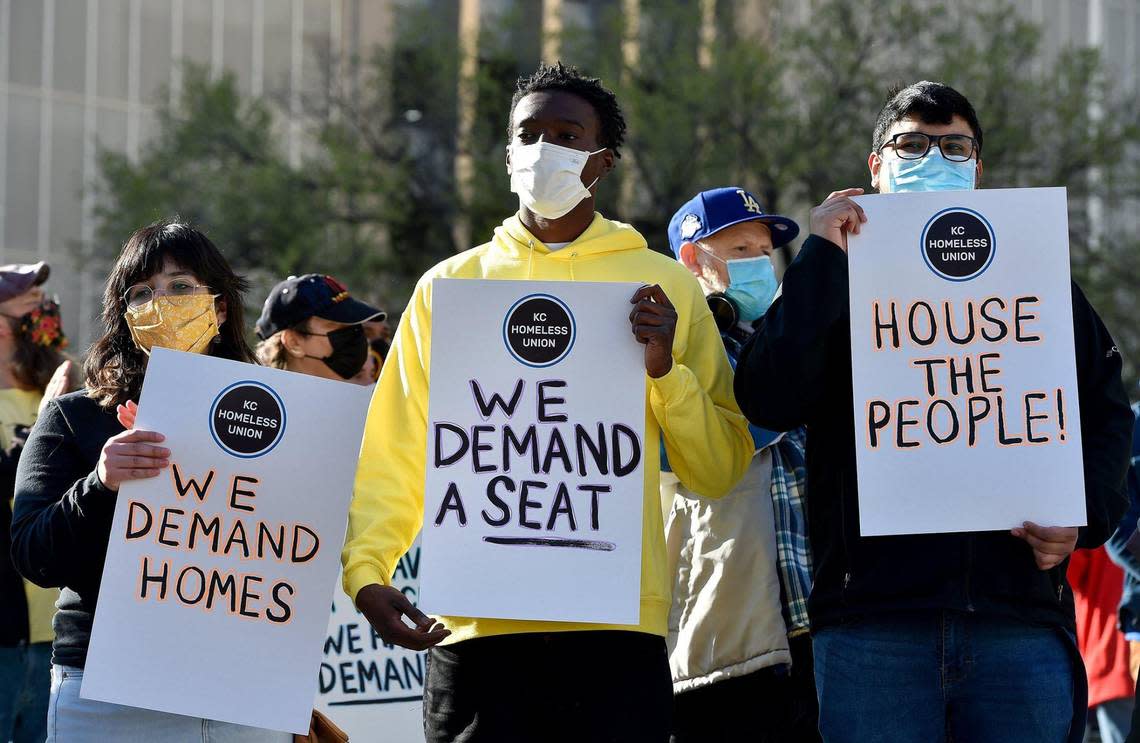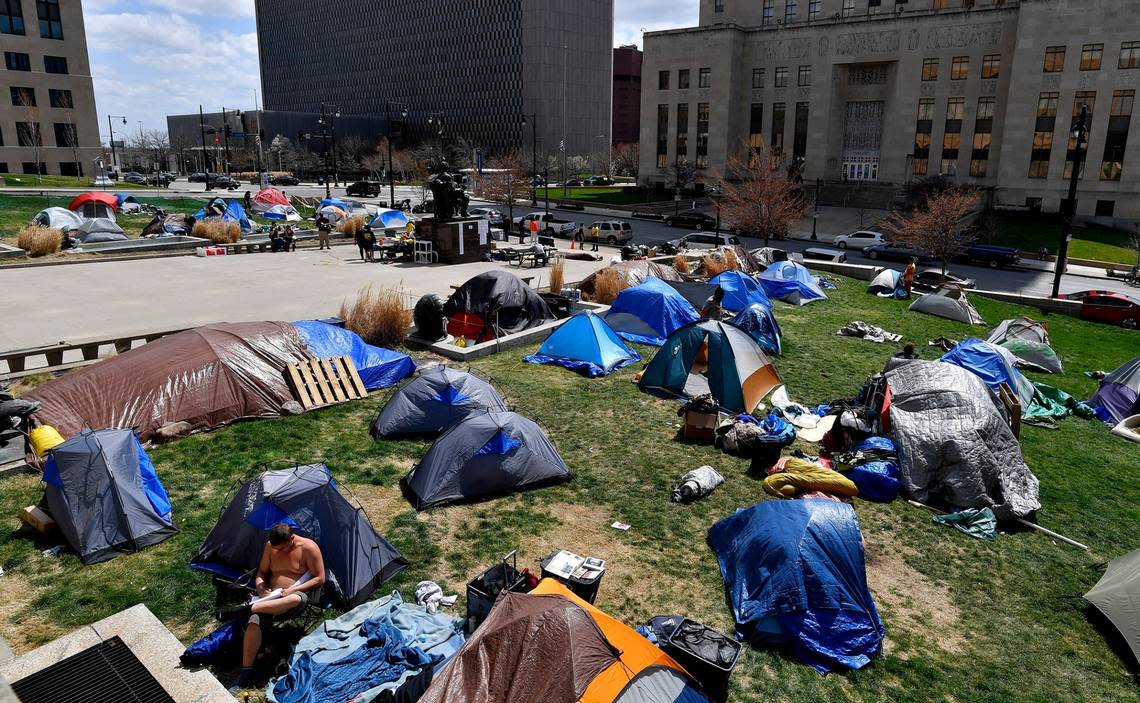KC may scrap plan for ‘low barrier’ shelter. Why such little progress on homeless goals?
Reality Check is a Star series holding those with power to account and shining a light on their decisions. Have a suggestion for a future story? Email our journalists at RealityCheck@kcstar.com.
Plans for Kansas City’s first low barrier emergency shelter — considered a key part and the first major goal of the city’s initiative to address homelessness — appear to have gone adrift, causing frustration among advocates for the unhoused community.
In 2023, the City Council unanimously passed an ordinance to establish the first low barrier shelter in the city as part of their five-year plan to drastically reduce homelessness.
That plan, called Zero KC, is a strategic effort first announced in September 2022, which aims to end the growing problem of homelessness in Kansas City. The plan was produced by the city’s Houseless Task Force, which Kansas City Mayor Quinton Lucas created in 2021 after members of the homeless community camped out for weeks on the lawn of City Hall.
But while the plan suggested new policies, it didn’t mandate them. Instead, any policy that arose in support of the plan required separate approval from the City Council.
In January, Mayor Lucas introduced an ordinance to approve a plan for a low barrier shelter from Hope Faith Ministries, a nonprofit organization in Kansas City that works to assist people experiencing homelessness. A total of $7.1 million in funding was set aside from the American Rescue Plan Fund to build the shelter.
The council reportedly selected the plan from Hope Faith Ministries because theirs was the only plan that added low barrier shelter beds, meaning the beds are accessible without needing to meet preconditions, to anyone regardless of race, religion, substance use or other circumstance.
“This is the first major piece of what (the city) wants and what we desperately need,” said Doug Langner, executive director at Hope Faith Ministries. “We don’t have a low barrier shelter period. And a city this size, that’s unconscionable.”

A low barrier shelter, Langner said, allows anyone in as long as they are not a danger to themselves or others. There is no “pray to stay” requirement, program to join, breathalyzer test or gender restriction. Instead, as Langner explained, “This is a place to come in and stabilize and get off the streets.”
This week, however, that plan could come to a halt, leaving the city and homeless advocates to start over. Advocates say the City Council is expected to scrap the current plan and request a new proposal from Hope Faith Ministries, as well as to reopen it to other organizations to reapply. It’s a development that’s left homeless advocates frustrated and asking questions, particularly since the reasons for the change have not been made publicly clear.
“It is disheartening. If they’re listening to experts, I want to know who they are,” Langner said.
Langner said he’s sure Hope Faith Ministries presented a sound plan, noting he researched what other cities across the country with a high homelessness issue did to curb the problem, spoke with experts and made sure that he followed all necessary steps in the proposal.
The impacts of shelving the plan and starting over are troubling, advocates say, particularly since a solution was already within reach.
According to one source close to the shelter negotiations, who the Star is not naming due to fear of retribution, “Not only was the proposal sound, very sound, (Hope Faith) has 10 years established experience working with this population.”
Councilmember Crispin Rea told The Star that, this time, the terms may be broader as to what the limitations are around the low barrier beds and the design of the structure. He said a delay, while unfortunate, does not mean the city is abandoning the goal of getting people off the streets.
“It would be kind of a deviation in the process, but I don’t think there’s any lack of commitment to try and find a solution on this,” Rea said. “Every neighborhood meeting I go to, every community meeting I go to, I hear folks talking about the challenges we have with serving our homeless folks.”
The need for low barrier shelters

This winter, Hope Faith Ministries received funding from the city to create a low barrier shelter for three months. It was a great success, Langner said, highlighting the need for a permanent shelter. He said he did not receive any complaints from surrounding neighborhoods, and said many unhoused individuals used their services and took steps toward permanent housing. The low barrier shelter, he said, is a critical first step to solving homelessness in the city.
For those who are unhoused, the need for low barrier shelters is painfully obvious.
Ryan is 37 or 38. He’s not sure. On Monday, he got a new pair of glasses and can see clearly for the first time in a while. He’s been living on the street for about a year. He has a job now, but doesn’t quite have enough to move into an apartment.
Hope Faith Ministries allows him to shower and hang around during the morning, but after 2 p.m. they close their doors. After that, unhoused people like Ryan struggle with finding someplace to go.
Having access to a low barrier shelter, he said, would give him the ability to prepare for his job.
“For me, to have somewhere to stay so I can get to work to keep my job, that would help me,” he said. “Over the winter when it was freezing cold, places like this were open, so it’s helpful in times like that and all the services.”
Ryan has a three-year-old daughter in Independence that he hasn’t seen in over a year, a wound that’s very raw.
“It hurts, she’s my world. She’s my only child,” Ryan said.
He’s currently working on getting an apartment but is worried he doesn’t make three times the rent, noting that “not everyone who is homeless is lazy or sitting around and doing drugs. There’s people out there trying hard to rebuild everything and getting over all those intense emotions.”
Jeremiah, 42, was born on a military base in Germany and brought up in a little farm in southwestern Missouri. He has also been homeless for around a year. After he lost his job, he got behind on rent and struggled to find work.
Shelters allow him to make sure he is clean for interviews and charge his phone, he said. He also now has a full-time job and is saving up for deposits and apartment application fees. A low barrier shelter would give him a place to stay in the interim, and allow him to use the facilities after he’s done working.
His long term goal, he said, is, “to not only have my own home, but to have my own little piece of land too that I can take care of and manage and walk on peacefully. That’s been a dream for a long time.”
Jeremiah said he’s noticed when something is wrong with the city, people are quick to blame the homeless community.
“It’s not always true. There’s a lot of other house-dwelling citizens that throw their litter on the ground. Cigarette butts just all sorts of things, you know, that (the housed) toss away. So it’s not just unhoused that are creating litter on the streets,” he said.
“This whole place is very special for people like me,” said Carl Weems, 41, who’s been homeless for ten years. “People like me, we don’t have anything else. “
A low barrier shelter would be an important asset for the unhoused community, Weems said, allowing them refuge from the elements throughout the year. After Hope Faith closed their temporary winter shelter, Weems began sleeping in the nearby park.
But Weems, like many other people experiencing homelessness, knows the sight of people sleeping in parks or other open spaces can make other residents uncomfortable. He said people tend to view unhoused people as potentially dangerous. He counters that view by saying, “Everybody ain’t like that. I’m not like that. I don’t hurt people, I don’t bother people. I mind my business.”
And while he carries the faith that he’ll one day make his way out of homelessness, and get a chance to realize a personal dream of learning to play the drums, he knows that finding shelter in the meantime is key to his survival.
What’s hindering the low barrier shelter plans?

Rea said the people he’s spoken to in Northeast neighborhoods where the shelter was planned to be located, acknowledge there is need for the low barrier shelter and say they’re happy to have part of it in their community, but they don’t want to carry the full load for the entire city.
“They had concerns about a complete concentration for the low barrier beds being exclusively located in their neighborhood,” he said.
Langner was quick to say they’d love to have multiple low barrier shelters, but added that, realistically, they had to start somewhere. He thought it made the most sense to locate it where unhoused people already are.
“Houseless people don’t think about City Council districts,” he said. “They think about where can I get in, who will accept me , who will help me and who do I trust.”
City officials insist they are committed to addressing homelessness.
Mayor Pro Tem Ryana Parks-Shaw pointed to the creation of the position of houseless prevention coordinator and other staff designated to tackle the problem as a sign of the city’s dedication to addressing the issue. The low barrier shelter is the first major step, she said, but she added there are other things also in the works.
“I’m really proud of the work that we’ve done to help our unhoused get access to jobs,” she said, citing one example.
But advocates say there’s no good reason the city shouldn’t be moving forward with the plan already in place to build a low barrier shelter.
“The money is there. It’s free, it’s from the feds. It costs the city nothing. The only money we have spent is our time chasing our tails because they keep kicking this can down the road,” said one source with knowledge of the plan.
The source said a vast majority of those who are homeless are there because of circumstance, meaning that if that circumstance could be fixed, the person would not be homeless. The first step, they said, is to find them a safe place to sleep and help them get out of the fight or flight mode.
“The starting point in every other major American city is a low barrier shelter. The fact is, we don’t have one,” the source said.
Emphasizing more resources for programs rather than the shelter, the source said, is comparable to having teachers create a lesson plan for their class without a school building to teach in. It’s like asking for doctors but having no hospital, they said.
“Homelessness is like rust on a car,” the source said. “You’re never gonna go to the garage, and the rust is going to be gone. It’s not going to happen. You must address it.”
In February, leaders at Hope Faith Ministries, along with religious leaders, advocates and several unhoused people stood outside city hall in protest, demanding the ordinance be enacted so work could begin on the shelter.
It’s progress they fear could now be lost.
If the city decides this week to reopen the request for proposal, they will start over from square one. Applicants, including Hope Faith Ministries, would have to reapply and go through the procurement process once again. In response to the end of year deadline set by the federal government, Rea said that he believes staff are aware and are eager to move quickly in order to not jeopardize funding.
Anna Spoerre contributed to this report.
